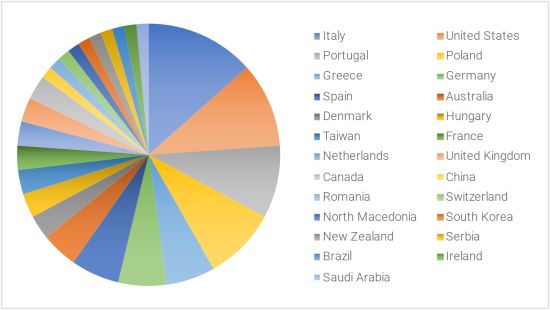Indexing: Web of Science (ESCI), Scopus (CiteScore: 1.2)
Search Articles
Journal:
Highlights of Sustainability
Total
—
78 articles
Editorial 21 Dec 2023
Highlights of Sustainability Editorial Office
Highlights of Sustainability
Volume 2 (2023), Issue 4, pp. 303–304
Volume 2 (2023), Issue 4, pp. 303–304
2305 Views396 Downloads
Article 16 Nov 2023
Mahdi Mahmoudzadeh
This article is part of the Special Issue Capturing the Sustainable Impact of Early-Stage Business Models.
Highlights of Sustainability
Volume 2 (2023), Issue 4, pp. 283–302
Volume 2 (2023), Issue 4, pp. 283–302
2784 Views1213 Downloads
Article 15 Nov 2023
Irina Di Ruocco
This article is part of the Special Issue Capturing the Sustainable Impact of Early-Stage Business Models.
Highlights of Sustainability
Volume 2 (2023), Issue 4, pp. 259–282
Volume 2 (2023), Issue 4, pp. 259–282
3211 Views1202 Downloads1 Citations
Article 11 Nov 2023
Sevasti Malisiova and Stella Kostopoulou
Highlights of Sustainability
Volume 2 (2023), Issue 4, pp. 241–258
Volume 2 (2023), Issue 4, pp. 241–258
3791 Views1015 Downloads1 Citations
Article 2 Nov 2023
Constanze Trautwein
This article is part of the Special Issue Capturing the Sustainable Impact of Early-Stage Business Models.
Highlights of Sustainability
Volume 2 (2023), Issue 4, pp. 224–240
Volume 2 (2023), Issue 4, pp. 224–240
3102 Views1271 Downloads
Article 6 Oct 2023
Felice Diekel, Vanessa Bach and Matthias Finkbeiner
This article is part of the Special Issue Capturing the Sustainable Impact of Early-Stage Business Models.
Highlights of Sustainability
Volume 2 (2023), Issue 4, pp. 207–223
Volume 2 (2023), Issue 4, pp. 207–223
5986 Views1914 Downloads2 Citations
Article 22 Sep 2023
Carlo Berizzi, Margherita Capotorto, Gaia Nerea Terlicher and Luca Trabattoni
Highlights of Sustainability
Volume 2 (2023), Issue 4, pp. 185–206
Volume 2 (2023), Issue 4, pp. 185–206
3857 Views1075 Downloads1 Citations
Article 7 Aug 2023
Karina Cagarman, Kristina Fajga and Jan Kratzer
This article is part of the Special Issue Capturing the Sustainable Impact of Early-Stage Business Models.
Highlights of Sustainability
Volume 2 (2023), Issue 3, pp. 171–184
Volume 2 (2023), Issue 3, pp. 171–184
3896 Views1297 Downloads4 Citations
Article 25 Jul 2023
Anastasia-Alithia Seferiadis, Sarah Cummings and George Essegbey
The article considers the extent to which social entrepreneurship of young women is contributing to sustainable development in Ghana, based on field research conducted between October 2018 and April 2019. Data collection involved a review of
The article considers the extent to which social entrepreneurship of young women is contributing to sustainable development in Ghana, based on field research conducted between October 2018 and April 2019. Data collection involved a review of the literature and a questionnaire survey of actors within the social entrepreneurship ecosystem in Ghana but is primarily based on the life histories of 13 women entrepreneurs collected using in-depth semi-structured interviews. Social entrepreneurship is undergoing a boom in Ghana which is characterized as having the most entrepreneurs as a proportion of the population globally and with women outnumbering men. Critical discourse analysis was employed to highlight the potential difference between grand narratives of entrepreneurship for development—how it is supposed to work, and how it is working in practice for young women social entrepreneurs in Ghana. The life histories demonstrate that the social entrepreneurship of young women in Ghana does not appear to be contributing to sustainable development because the enterprises yielded small or non-existent economic benefits for the entrepreneurs, demonstrating the limitations of this framework in the Ghanaian context. Indeed, most of the enterprises do not go beyond the ideation stage while the fame of winning social entrepreneurship competitions is used by individuals to build social and symbolic capital for employment by the public sector and the United Nations. In this way, young women are “hacking” social entrepreneurship for their own purposes as it is one of the opportunities open to them but it does not lead to sustainable enterprises. While the social entrepreneurship sector in Ghana is booming, it appears in reality to be a survival activity for women who are subject to gender inequalities and social-cultural harassment.
or
Access Full Article
Highlights of Sustainability
Volume 2 (2023), Issue 3, pp. 157–170
Volume 2 (2023), Issue 3, pp. 157–170
3416 Views3321 Downloads
Article 21 Jul 2023
Nikolaos Partarakis, Effrosini Karouzaki, Stavroula Ntoa, Anastasia Ntagianta, Emmanouil Zidianakis and Constantine Stephanidis
Highlights of Sustainability
Volume 2 (2023), Issue 3, pp. 138–156
Volume 2 (2023), Issue 3, pp. 138–156
4195 Views1009 Downloads1 Citations
